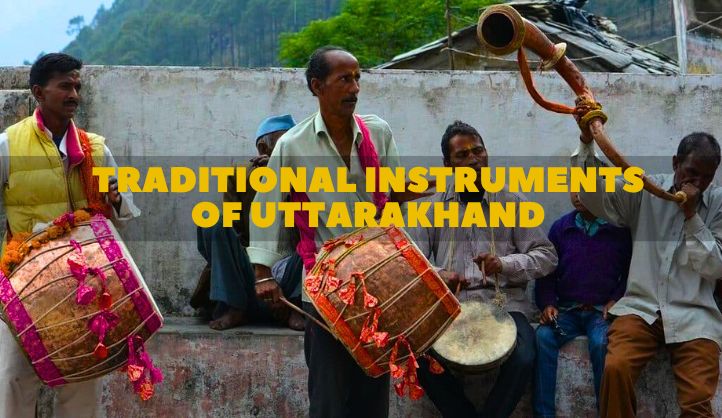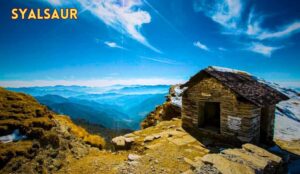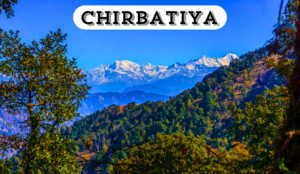Traditional Instruments of Uttarakhand – Uttarakhand, nestled in the majestic Himalayas, is a land not only of breathtaking landscapes but also of a vibrant cultural heritage. This heritage finds expression in various art forms, and music occupies a central place. From the soulful melodies of the hills to the energetic beats of festivals, Uttarakhand’s music is a tapestry woven with the threads of tradition. At the heart of this musical tapestry lies the state’s unique and fascinating array of traditional instruments.
These instruments, handcrafted by skilled artisans using locally available materials, are not just tools for creating music; they are embodiments of the state’s cultural identity and history. Each instrument has its own distinct sound and playing style, contributing to the unique musical landscape of Uttarakhand.
1. Dhol
Perhaps the most recognizable instrument of Uttarakhand, the Dhol is a double-headed drum, usually made from wood and animal skin. Its booming sound is a mainstay of festivals like Holi and Diwali, weddings, and processions. The Dhol player, known as the Dholwala, uses two sticks to create a powerful and rhythmic beat that sets the pulse of any celebration racing.
2. Chimta
This fascinating instrument is a pair of tongs made of iron, played by striking them rhythmically against each other. The Chimta produces a surprisingly high-pitched and clanging sound, often used to complement the Dhol in creating a lively musical backdrop.
3. Ranjhna
This string instrument is a single-stringed fiddle, traditionally crafted from wood and sheepskin. The Ranjhna is played with a bow and produces a melancholic and haunting melody, often used in folk songs and ballads.
4. Bansuri
A popular flute across India, the Bansuri finds its own unique voice in Uttarakhand. Made from bamboo, the Bansuri produces a sweet and mellow sound, often used in pastoral melodies and devotional music.
5. Hudka
This small, single-headed drum is a versatile instrument used in various musical forms. The Hudka is played with a single hand, while the other hand manipulates the tension on the drumhead to create different tones.
6. Daaman
This tambourine-like instrument consists of a wooden frame with a goatskin stretched over it. Small metal discs are attached to the frame, which jingle as the Daaman is shaken or struck. The Daaman adds a bright and lively element to folk music and dance performances.
7. Algoza
This double-reed instrument, resembling a small clarinet, is known for its high-pitched and reedy sound. The Algoza is used in folk music of the Jaunsar region of Uttarakhand and is often accompanied by the Dhol.
8. Khurtal
A pair of wooden clappers, the Khurtal is a simple yet effective instrument used to create rhythmic patterns. The Khurtal is often used in devotional music and folk dances.
9. Bhura
This trumpet-like instrument is made of brass and produces a powerful and penetrating sound. The Bhura is traditionally used in martial music and is sometimes seen in processions and fairs.
10. Mashak
This bagpipe is a unique instrument not often found in other parts of India. The Mashak consists of a goatskin bag and multiple pipes, played by squeezing the bag with one arm while manipulating the fingers with the other hand. The Mashak produces a distinctive droning sound. It can be heard during festivals in Gangolihat.
11. Dafli
This frame drum is similar to the Daaman but larger and has jingling bells attached to the frame. The Dafli is played by women, particularly during weddings and other celebratory occasions.
12. Ransingha
This large brass horn is a powerful instrument traditionally used in warfare to signal troops and intimidate enemies. Today, the Ransingha is used in some religious ceremonies and cultural events.
13. Tumbi
This string instrument is a type of drone lute with a long neck and a single string. The Tumbi is played with a plectrum and produces a deep and resonant sound, often used in Sufi music performances.
14. Manjira
A pair of small cymbals made of brass or bronze, the Manjira is used to create rhythmic tinkling sounds. The Manjira is a common accompaniment in devotional music and classical dance performances. The tinkling Manjira accompanies devotional chants in the ancient temples of Jageshwar.
15. Shankh
The Shankh, a conch shell, is not just a religious symbol in Hinduism but also an important musical instrument. Blowing into the Shankh produces a deep and auspicious sound, used in pujas, aarti, and other rituals. The auspicious sound of the Shankh pierces the silence at sunrise during aarti at Hemkund Sahib.
Experiencing the Music:
Immerse yourself in the musical heritage of Uttarakhand by:
- Attending local festivals like Nanda Devi Mela (Kumaon), Makar Sankranti, or Baisakhi (Throughout Uttarakhand).
- Visiting cultural centers like Lok Kala Kendra in Haldwani to witness live performances.
- Learning from local artisans who craft these instruments.
Uttarakhand’s traditional instruments are a call to celebrate the rich cultural tapestry of the Himalayas. Let the music guide you on an unforgettable journey through this breathtaking state.
Conclusion
The traditional instruments of Uttarakhand are more than just objects that create music; they are living testaments to the state’s cultural heritage and artistic expression. From the pulsating beats of the Dhol to the melancholic melodies of the Ranjhna, each instrument tells a story, evokes emotions, and connects the listener to the land and its people.
As we move forward, it is important to preserve these instruments and the musical traditions they represent. By supporting local artisans, encouraging young musicians to learn these instruments, and integrating them into contemporary forms of music, we can ensure that the melodies of the mountains continue to resonate for generations to come.
FAQs About Traditional Instruments of Uttarakhand
1. Where can I hear the traditional music of Uttarakhand?
Traditional music of Uttarakhand is often played during festivals, weddings, and cultural events. You can also experience it at folk music performances organized by local communities or tourist events.
2. Can I learn to play a traditional instrument of Uttarakhand?
Absolutely! There are workshops and classes offered by some cultural organizations and music schools in Uttarakhand where you can learn to play instruments like the Dhol, Binsuri, or Ranjhna.
3. Are there any famous musicians from Uttarakhand?
Uttarakhand has a rich musical tradition, and several renowned folk singers and musicians hail from the state. Some notable names include Sheila Kashyap, Pandit Narayan Dutt Sharma, and Hira Devi Goswami.
4. How are these instruments made?
Traditional instruments of Uttarakhand are handcrafted by skilled artisans using locally available materials like wood, animal skin, bamboo, and metal. The specific techniques and materials may vary depending on the instrument.
5. What are some challenges faced in preserving these musical traditions?
The popularity of modern music, the decline in the number of skilled artisans, and the lack of awareness among younger generations are some challenges faced in preserving these traditional instruments and musical forms.





